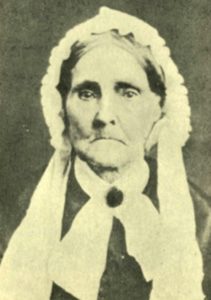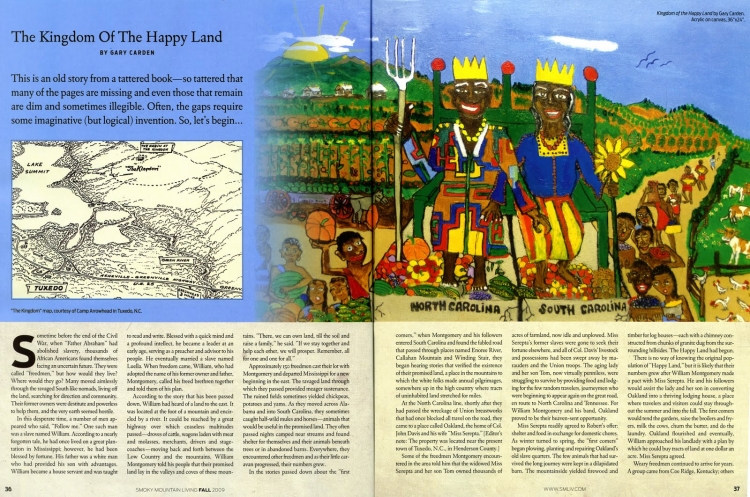February is Black History Month. To honor that history, Appalachia Bare will endeavor to reveal the true tale of a Kingdom once nestled inside Appalachia’s beautiful Blue Ridge Mountains. The story begins with a group of emancipated slaves who journeyed to find a place of their own and wound up in North Carolina. Though they were free at the time, former slaves had no “place” in the world, and many wandered without direction, home, or, in many cases, family, searching for community and livelihoods. Freeperson, William Montgomery, led a group of emancipated slaves on a journey to find such a place. And find it they did. The Kingdom of Happy Land1)Some sources also name the area The Kingdom of the Happy Land. was born from a hopeful vision, unwavering determination, and keen ancestral reverence.
William Montgomery was a slave on a Mississippi plantation, purportedly as a house servant. Sources mentioned he was biracial with a white father and a black mother. Counter to the slaveowners rules of non-education and forced illiteracy, William was educated. Several sources believe he may have owned slaves himself.2)More than a few men named “William Montgomery” appear on Mississippi’s slave census. Though the sources “think” or “believe” he owned slaves, I found no concrete evidence that he did. And if he did, he may well have done so to protect people. After all, William led people – free people – to a good place and formed a good community.
After the slaves were emancipated, Montgomery weighed their collective prospects. He had a great desire to live as a united community in an African utopia. He believed they could find such a place in the mountains of Appalachia, so he led them all on a journey through several states: Alabama, Georgia, South Carolina, and, ultimately, North Carolina. Sources vary as to the group’s number, and state anywhere from 50 to 150.3)Flat Rock Together. 2021. “Kingdom of the Happy Land.” Flat Rock Together. Feb 6.4)Carden, Gary. 2009. “The Kingdom of the Happy Land.” Smoky Mountain Living Magazine. Sept 1. An online article in the Charleston Mercury, quotes Gary Franklin Greene’s book, A Brief History of The Black Presence in Henderson County and touches on biblical similarities in their journey:
It is a story, not unlike the biblical one of Moses and a band of wandering people who left the intolerably harsh conditions of slavery to begin a new life. Their dream was rooted in an ancestral tribal memory and sustained by the hope for a Promised Land.
The group arrived in North Carolina on land that belonged to one Serepta Merritt Davis. She inherited the property after her husband, John Davis, died. John was from Virginia. His parents came to America from Wales. Davis fought in the War of 1812, serving under General Andrew Jackson. Davis bought land in Flat Rock, Henderson County, North Carolina. He and Serepta lived there and managed an inn next to the main road. Given the easy access, stagecoaches and travelers often stopped there. Some years later, Davis sold his land and subsequently bought somewhere between two hundred and a thousand acres (depending on the source)5)Several sources list the amount as 1,000 acres. However, Terry Ruscin, in a Blue Ridge Now News article entitled “Beyond the Banks: Promised land, Henderson County’s storied kingdom” provides documented information. Ruscin writes that Davis purchased two hundred acres in the adjacent Buncombe County in 1830. Evidence is found in Buncombe County’s deed records. However, the Happy Land residents later purchased 180 acres of Davis land. So, it’s doubtful that Serepta and her living children would’ve sold so much land leaving the family only 20 acres. The more likely scenario is that John Davis purchased many acres of land from several areas in North and South Carolina. This, though, would take digging and wading through documents to confirm. along the border of North and South Carolina. He commissioned another inn on this new property and named it Oakland, supposedly due to the great number of oaks in the area. Oakland Inn was a “substantial brick home”6)Ruscin, Terry. 2019. “Beyond the Banks: Promised land, Henderson County’s storied kingdom.” Blue Ridge Now Times News. Feb 9. that soon became a popular stop for travelers.

John died in 1859 and left Oakland and the surrounding property to Serepta. She lived at the inn with her son.7)John and Serepta had at least ten children. They continued the business, but travelers were scarce and income trickled. She became “virtually penniless . . . struggling to survive.”8)Flat Rock Together. 2021. “Kingdom of the Happy Land.” Flat Rock Together. Feb 6. Consequently, the house fell into disrepair.
William and the group of free persons arrived on the Davis land sometime between 1865 – 1866. He and Serepta spoke and came to an agreement. She offered Montgomery and the group housing and land if they, in turn, worked for her to help revive Oakland. Montgomery had found his “promised land.” The group worked hard to get Oakland up and running. More travelers came through and Oakland met more success.
Eventually, Montgomery and the new residents bought 180 acres9)According to Conserving Carolina’s 2019 article “The Kingdom of the Happy Land,” records show the purchase of the 180 acres was in 1882. of the Davis land for one dollar an acre. The stretch of land sprawled across the North and South Carolina borders. Families built log cabins, sheds, storehouses, corncribs, and tended gardens. One house became a chapel and schoolhouse. The community’s goal was to “revive the African culture” and “build a new tribe” that kept their African heritage.10)Flat Rock Together. 2021. “Kingdom of the Happy Land.” Flat Rock Together. Feb 6. They named the area the “Kingdom of Happy Land.” By 1870, the group ostensibly numbered 400. They became a self-sustainable and shared community by 1873.
William married a woman named Louella (sometimes spelled Luella), who was also educated, and, together, they became Happy Land’s first king and queen.11)Flat Rock Together. 2021. “Kingdom of the Happy Land.” Flat Rock Together. Feb 6. Folklore says they even had thrones.12)Carden, Gary. 2009. “The Kingdom of the Happy Land.” Smoky Mountain Living Magazine. Sept 1. They lived in separate but adjacent cabins, with William’s cabin in North Carolina, and Louella’s cabin in South Carolina. The reason for this oddity was simple. If something happened, at least half of the Kingdom would survive. William and Louella “served as teachers and priests for the kingdom.” 13)After William died, his brother Robert became king and Louella remained queen.14)Flat Rock Together. 2021. “Kingdom of the Happy Land.” Flat Rock Together. Feb 6. According to several sources, Louella was a benevolent and thoughtful person who taught the children not only curriculum, but also music, hymns, and spirituals. She and her choir were called the “Kingdom Singers,”15)Flat Rock Together. 2021. “Kingdom of the Happy Land.” Flat Rock Together. Feb 6. and sources say they sang beautifully. They were welcomed by persons everywhere.
Happy Land had several sources of income. They manufactured a “natural curative, Happy Land Liniment.”16)Flat Rock Together. 2021. “Kingdom of the Happy Land.” Flat Rock Together. Feb 6. They reportedly sold a “Balm of Gilead” that helped with appetite.17)Carden, Gary. 2009. “The Kingdom of the Happy Land.” Smoky Mountain Living Magazine. Sept 1. They also farmed crops and made crafts. Some worked outside the Kingdom in blue-collar and service jobs. The residents’ main source of income was a teamster service hauling goods to various farmers and inns in Happy Land wagons. They transported “loads of market goods up the old ‘State Road’ that linked the South Carolina piedmont and coastal ports like Charleston with the WNC [Western North Carolina] mountains.”18)Elliston, Jon and Kent Priestly. 2007. “The Kingdom of the Happy Land.” Mountain Xpress. Feb 7. Some say they even made moonshine, and, if they were pursued, “they would step across the line into another jurisdiction.”19)Flat Rock Together. 2021. “Kingdom of the Happy Land.” Flat Rock Together. Feb 6. All monies went into a collective treasury. William, as king, was responsible for the money, and distributed it as required. He also “developed a network of storage barns and bought more land.”20)Carden, Gary. 2009. “The Kingdom of the Happy Land.” Smoky Mountain Living Magazine. Sept 1.

The Kingdom of Happy Land’s decline began in 1900 for several reasons. The first reason is due to the railroad system. The railroad delivered goods in greater quantity and with more speed than Happy Land wagons. In effect, the railroad put Happy Land out of business. Residents left the Kingdom to find work. Another reason for the decline was a lack of new inhabitants. People moved out of the country to larger cities and towns.21)At one time, however, traveling preacher, Reverend Ezel became a “self-appointed recruiter” for Happy Land. He preached in small towns and gathered future residents like a “19th century Moses who led the chosen to the Happy Land.” Further, in 1889, Happy Land was in arrears on taxes. Some sources say the community was ultimately forced to sell. Other sources state the property was seized by Henderson County.
Today, all that’s left of William Montgomery’s vision are a few destroyed chimneys, root cellar remnants, foundation stones, springhouses, and unmarked graves. Joseph Oscar Bell bought some of the land in 1910 and the original houses were subsequently demolished. Bell’s progenies explain why the structures were destroyed. Apparently, people heard the residents hid gold and silverware in the abandoned homes, so fortune seekers tore the homes apart looking for treasure. Sadly, their endeavor and experiences weren’t documented or written. All we have are oral stories told decades later.
![]()
Websites and articles used as research (including footnote information):
“Kingdom of the Happy Land” – Flat Rock Together – February 6, 2021
“The Kingdom of the Happy Land” by Gary Carden – Smoky Mountain Living Magazine – September 1, 2009
“The Kingdom of the Happy Land” – Conserving Carolina – January 27, 2019
“Seeking the Kingdom of Happy Land” – Random Connections – July 10, 2017
“The Happy Land: Former Slaves Forged a Communal Kingdom in Henderson County” by Jon Elliston – WNC Magazine – Winter Issue 2021
“A Black kingdom in postbellum Appalachia” by Danielle Dulkin – SCALAWAG –September 9, 2019
“Serepta Merritt Davis,” bplevi – Find-a-Grave –August 29, 2007
“Beyond the Banks: Promised land, Henderson County’s storied kingdom” by Terry Ruscin – BlueRidgeNow, Times News – on February 9, 2019
“African-American history in Henderson County, Part One: The Kingdom of the Happy Land” – Charleston Mercury – n.d., unknown author
“The Kingdom of the Happy Land” by Jon Elliston and Kent Priestly – Mountain Xpress – February 7, 2007
“African-American history in Henderson County, Part Two” – Historic Flat Rock Inc – February 24, 2021
For more information, read:
Sadie Smathers Patton’s The Kingdom of the Happy Land (Stephens Press, 1957)
Gary Franklin Greene’s A Brief History of the Black Presence in Henderson County, (The Black History Research Committee of Henderson County, 1996)
An interview with Frank Bell by Northwest Middle School in Traveler’s Rest, S.C., 1985
**Featured image by Agnali on Pixabay
References
| ↑1 | Some sources also name the area The Kingdom of the Happy Land. |
|---|---|
| ↑2 | More than a few men named “William Montgomery” appear on Mississippi’s slave census. Though the sources “think” or “believe” he owned slaves, I found no concrete evidence that he did. And if he did, he may well have done so to protect people. After all, William led people – free people – to a good place and formed a good community. |
| ↑3, ↑8, ↑10, ↑11, ↑14, ↑15, ↑16, ↑19 | Flat Rock Together. 2021. “Kingdom of the Happy Land.” Flat Rock Together. Feb 6. |
| ↑4, ↑12, ↑17, ↑20 | Carden, Gary. 2009. “The Kingdom of the Happy Land.” Smoky Mountain Living Magazine. Sept 1. |
| ↑5 | Several sources list the amount as 1,000 acres. However, Terry Ruscin, in a Blue Ridge Now News article entitled “Beyond the Banks: Promised land, Henderson County’s storied kingdom” provides documented information. Ruscin writes that Davis purchased two hundred acres in the adjacent Buncombe County in 1830. Evidence is found in Buncombe County’s deed records. However, the Happy Land residents later purchased 180 acres of Davis land. So, it’s doubtful that Serepta and her living children would’ve sold so much land leaving the family only 20 acres. The more likely scenario is that John Davis purchased many acres of land from several areas in North and South Carolina. This, though, would take digging and wading through documents to confirm. |
| ↑6 | Ruscin, Terry. 2019. “Beyond the Banks: Promised land, Henderson County’s storied kingdom.” Blue Ridge Now Times News. Feb 9. |
| ↑7 | John and Serepta had at least ten children. |
| ↑9 | According to Conserving Carolina’s 2019 article “The Kingdom of the Happy Land,” records show the purchase of the 180 acres was in 1882. |
| ↑13 | After William died, his brother Robert became king and Louella remained queen. |
| ↑18 | Elliston, Jon and Kent Priestly. 2007. “The Kingdom of the Happy Land.” Mountain Xpress. Feb 7. |
| ↑21 | At one time, however, traveling preacher, Reverend Ezel became a “self-appointed recruiter” for Happy Land. He preached in small towns and gathered future residents like a “19th century Moses who led the chosen to the Happy Land.” |






Thanks for this interesting read and colorful bit of Henderson County history. I sometimes bike the backroads from Tuxedo to Saluda and wonder if I might have unknowingly passed the former site of the Kingdom of the Happy Land.
I’m glad you liked it, Jim! I wouldn’t doubt that you did pass it. I enjoyed doing research on this story.